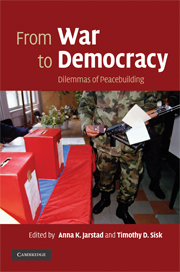Book contents
- Frontmatter
- Contents
- List of tables
- About the authors
- List of acronyms
- Acknowledgments
- Introduction
- Part I The perils of war-to-democracy transitions
- Part II The security context
- Part III The political process
- 4 Power sharing: former enemies in joint government
- 5 When rebels change their stripes: armed insurgents in post-war politics
- 6 Post-war elections: uncertain turning points of transition
- 7 Civil society in war-to-democracy transitions
- Part IV International engagement
- References
- Index
7 - Civil society in war-to-democracy transitions
Published online by Cambridge University Press: 14 May 2010
- Frontmatter
- Contents
- List of tables
- About the authors
- List of acronyms
- Acknowledgments
- Introduction
- Part I The perils of war-to-democracy transitions
- Part II The security context
- Part III The political process
- 4 Power sharing: former enemies in joint government
- 5 When rebels change their stripes: armed insurgents in post-war politics
- 6 Post-war elections: uncertain turning points of transition
- 7 Civil society in war-to-democracy transitions
- Part IV International engagement
- References
- Index
Summary
In the 1980s Serbia, like all other Eastern European countries, witnessed a strong revival of civil society. Several non-governmental organizations (NGOs) and committees for the defense of different rights from freedom of expression to ecological protection were created – primarily among intellectual circles in Belgrade. In the second half of the decade many members of these organizations and groups began to move from demands for human rights and democratization to extreme nationalism which denied basic rights to members of other non-Serb national groups. Virtually all intellectuals and grass-root organizations supported Slobodan Milosevic's rise to power – identifying him as the champion of the Serb national cause. The outbreak of war in the 1990s, combined with Milosevic's controversial role in the protection of Serbs throughout the territory of the former Yugoslavia split the emerging civil society. Non-nationalist opposition to the regime's wars in Croatia, Bosnia, and Kosovo was dubbed the “other Serbia.” At the same time, however, extreme nationalist groups also criticized Milosevic, blaming him for having abandoned Serbs in Croatia and for having failed to support Serbs adequately in Kosovo – an area inhabited by an overwhelming majority of Albanians. The peaceful revolution of October 2000, ending thirteen years of Milosevic's rule, occurred because of a broad alliance among actors within civil society, including both nationalist and non-nationalist groups. The ouster of Milosevic, however, did not terminate the influence of uncivil, violent, and illegal groups – one of the legacies of the Milosevic era (Bieber 2003).
- Type
- Chapter
- Information
- From War to DemocracyDilemmas of Peacebuilding, pp. 182 - 210Publisher: Cambridge University PressPrint publication year: 2008
- 42
- Cited by

